Related Research Articles
The Goidelic or Gaelic languages form one of the two groups of Insular Celtic languages, the other being the Brittonic languages.
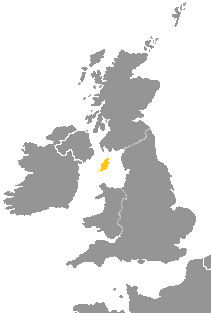
Manx, also known as Manx Gaelic, is a Gaelic language of the insular Celtic branch of the Celtic language family, itself a branch of the Indo-European language family. Manx is the historical language of the Manx people.
In Manx folklore, a buggane was a huge ogre-like creature native to the Isle of Man. Some have considered them akin to the Scandinavian troll.

The culture of the Isle of Man is influenced by its Celtic and, to a lesser extent, its Norse origins, though its close proximity to the United Kingdom, popularity as a UK tourist destination, and recent mass immigration by British migrant workers has meant that British influence has been dominant since the Revestment period. Recent revival campaigns have attempted to preserve the surviving vestiges of Manx culture after a long period of Anglicisation, and significant interest in the Manx language, history and musical tradition has been the result.
The Manx fairies were called Adhene and known as Cloan ny moyrn, which means the Children of Pride/Ambition, because they were regarded as having been fallen angels cast from heaven but too good for hell. They could be benevolent but were mostly mischievous in association with humans, taking babies or wives when they wished, although it was believed that their powers were not effective over any human on an errand of mercy.

Manx English, or Anglo-Manx, is the historic dialect of English spoken on the Isle of Man, though today in decline. It has many borrowings from Manx, a Goidelic language, and it differs widely from any other variety of English, including dialects from other areas in which Celtic languages are or were spoken, such as Welsh English and Hiberno-English.

Philip Anderson Gawne, better known as Phil Gawne, is a former Member of the House of Keys for Rushen, a constituency in the Isle of Man. He also served in a number of ministerial posts on the island and is therefore a former member of the Council of Ministers.

Hop-tu-Naa is a Celtic festival celebrated in the Isle of Man on 31 October. It is the celebration of the traditional Celtic festival of Samhain, the start of winter. It is thought to be the oldest unbroken tradition in the Isle of Man.

Sophia Morrison was a Manx cultural activist, folklore collector and author. Through her own work and role in encouraging and enthusing others, she is considered to be one of the key figures of the Manx cultural revival. She is best remembered today for writing Manx Fairy Tales, published in 1911, although her greatest influence was as an activist for the revitalisation of Manx culture, particularly through her work with the Manx Language Society and its journal, Mannin, which she edited from 1913 until her death.

Arthur William Moore, CVO, SHK, JP, MA was a Manx antiquarian, historian, linguist, folklorist, and former Speaker of the House of Keys in the Isle of Man. He published under the sobriquet A. W. Moore.
Fenodyree in the folklore of the Isle of Man, is a hairy supernatural creature, a sort of sprite or fairy, often carrying out chores to help humans, like the brownies of the larger areas of Scotland and England.
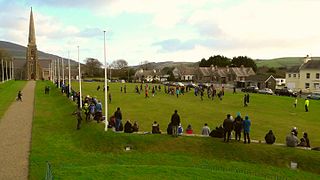
Cammag is a team sport originating on the Isle of Man. It is closely related to the Scottish game of shinty and is similar to the Irish game of hurling. Once the most widespread sport on Man, it ceased to be played around 1900 after the introduction of association football, though it has experienced a revival in the 21st century.
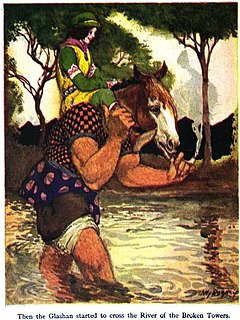
Glashtyn is a legendary creature from Manx folklore.
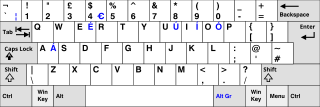
The main language of the Isle of Man is English, predominantly the Manx English dialect. Manx, the historical language of the island, is still maintained by a small speaker population.
Arkan sonney is the Manx term for hedgehog. In Manx folklore it is a type of fairy animal that takes the form of a white pig that brings good fortune to those who manage to catch it. It was even considered a favourable omen just to have seen the "lucky piggy". It was also said that if you caught one you would always find a silver coin in your pocket.

Fairy Bridge, Isle of Man is a small bridge over the Santon Burn in the Isle of Man, located on the primary A5 Port Erin to Douglas road, at grid reference 305720, on the parish boundary between Santon and Malew. A superstition associated with the Fairy Bridge is that passers-by must greet the fairies as they cross it; it is considered bad luck not to greet them.

Josephine Kermode (1852–1937) was a Manx poet and playwright better known by the pen name "Cushag".
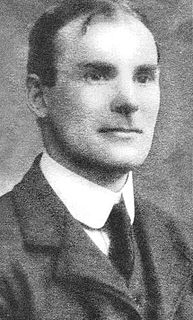
William Walter Gill (1876–1963) was a Manx scholar, folklorist and poet. He is best remembered for his three volumes of A Manx Scrapbook.

Edward Faragher (1831–1908), also known in Manx as Ned Beg Hom Ruy, was a Manx language poet, folklorist and cultural guardian. He is considered to be the last important native writer of Manx and perhaps the most important guardian of Manx culture during a time when it was most under threat. The folklorist, Charles Roeder, wrote that Faragher had "done great services to Manx folklore, and it is due to him that at this late period an immense amount of valuable Manx legends have been preserved, for which indeed the Isle of Man must ever be under gratitude to him."

Yn Çheshaght Ghailckagh, also known as the Manx Language Society and formerly known as Manx Gaelic Society, was founded in 1899 in the Isle of Man to promote the Manx language. The group's motto is Gyn çhengey, gyn çheer.
References
- ↑ Morrison, Sophia (1914). "Manx Dialect connected with the Fairies". Proceedings of the Isle of Man Natural History and Antiquarian Society. 1: 561–562. Retrieved 7 December 2006.
- ↑ Morrison, Sophia (1911). "Preface". Manx Fairy Tales. London: David Nutt. ISBN 1-4099-1040-7 . Retrieved 7 December 2006.
- 1 2 Moore, A.W. (1891). "The Folk-Lore of the Isle of Man". London: Brown & Sons.
- ↑ "Mooinjer Veggey - Official site". Mooinjer Veggey.